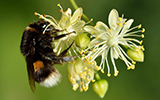seminar – Thursday 7th December 2017
 Conservation ecology and the theory of games
Conservation ecology and the theory of games
Andy Higginson, University of Exeter, UK
Thursday 7th December 2017, 11AM, amphitheatre Monge
Understanding the causes of the structure and dynamics of food webs is crucial for developing policies to halt the loss of biodiversity. I will argue that community and conservation ecology would benefit from the incorporation of advances in predicting animal behaviour, especially evolutionary game theory. I will focus on one example: the potential for loss of nest sites to cause great variation in the declines of closely-related species. I show that behaviours that evolved under competition could mean that some species may be driving others to extinction. Data on 221 bird and 43 bee species worldwide support my predictions. This phenomenon – anthropogenic competition – is likely to occur for any formerly abundant resources that suddenly, on an evolutionary timescale, are now limiting population sizes. I will explore several promising directions that could follow from a synthesis of behavioural and conservation ecology.
- kc_data:
- a:8:{i:0;s:0:"";s:4:"mode";s:0:"";s:3:"css";s:0:"";s:9:"max_width";s:0:"";s:7:"classes";s:0:"";s:9:"thumbnail";s:0:"";s:9:"collapsed";s:0:"";s:9:"optimized";s:0:"";}
- kc_raw_content:
 Conservation ecology and the theory of games
Conservation ecology and the theory of gamesAndy Higginson, University of Exeter, UK
Thursday 7th December 2017, 11AM, amphitheatre Monge
Understanding the causes of the structure and dynamics of food webs is crucial for developing policies to halt the loss of biodiversity. I will argue that community and conservation ecology would benefit from the incorporation of advances in predicting animal behaviour, especially evolutionary game theory. I will focus on one example: the potential for loss of nest sites to cause great variation in the declines of closely-related species. I show that behaviours that evolved under competition could mean that some species may be driving others to extinction. Data on 221 bird and 43 bee species worldwide support my predictions. This phenomenon – anthropogenic competition – is likely to occur for any formerly abundant resources that suddenly, on an evolutionary timescale, are now limiting population sizes. I will explore several promising directions that could follow from a synthesis of behavioural and conservation ecology.
